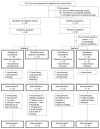Home intervention improves cognitive and social-emotional scores in iron-deficient anemic infants
- PMID: 20855384
- PMCID: PMC3230927
- DOI: 10.1542/peds.2009-3535
Home intervention improves cognitive and social-emotional scores in iron-deficient anemic infants
Abstract
Background: Iron-deficiency anemia (IDA) is associated with alterations in infant behavior and development that may not be corrected with iron therapy.
Objective: To determine if a home-based intervention to foster child development improves behavior and development of infants with IDA.
Methods: Infants with IDA and nonanemic infants aged 6 and 12 months were treated with oral iron and randomly assigned to a year of surveillance or intervention. Infants in the surveillance group were visited weekly, and information on iron intake, feeding, and health were recorded. Infants in the intervention were visited weekly, and the home visits included an hour-long program to foster child development by providing support to the mother-infant relationship. The number of infants enrolled was 128 (66 who received intervention) and 149 (70 intervention) at 6 and 12 months, respectively. Psychologists who were unaware of iron status and intervention assignment assessed infants' cognitive, motor, and social-emotional development (Bayley Scales) at the beginning, midpoint, and end of the year; 116 6-month-olds and 134 12-month-olds had at least 2 assessments. Hierarchical linear modeling was used to analyze change over time.
Results: Infants with IDA, regardless of enrollment age, were rated as less positive in social-emotional behavior at baseline. There were significant interactions between iron status and intervention associated with change in cognitive performance and positive social-emotional behavior. Infants with IDA who received intervention had developmental trajectories comparable to those of nonanemic infants in the intervention and surveillance groups, but these infants did not catch up in social-emotional behavior. Infants with IDA who received surveillance showed less increase in cognitive scores and had declines in positive social-emotional ratings.
Conclusions: Home-based intervention to foster child development improved cognitive and social-emotional scores in infants with IDA, but social-emotional differences remained between infants with IDA and those without IDA.
Trial registration: ClinicalTrials.gov NCT00998998.
Figures






References
-
- Walker SP, Wachs TD, Gardner JM, et al. Child development: risk factors for adverse outcomes in developing countries. Lancet. 2007;369(9556):145–157. - PubMed
-
- Grantham-McGregor S, Ani C. A review of studies on the effect of iron deficiency on cognitive development in children. J Nutr. 2001;131(2S-2):649S–668S. - PubMed
-
- Lozoff B. Iron deficiency and child development. Food Nutr Bull. 2007;28(4 suppl):S560–S571. - PubMed
-
- McCann JC, Ames BN. An overview of evidence for a causal relation between iron deficiency during development and deficits in cognitive or behavioral function. Am J Clin Nutr. 2007;85(4):931–945. - PubMed
-
- Sachdev H, Gera T, Nestel P. Effect of iron supplementation on mental and motor development in children: systematic review of randomised controlled trials. Public Health Nutr. 2005;8(2):117–132. - PubMed

